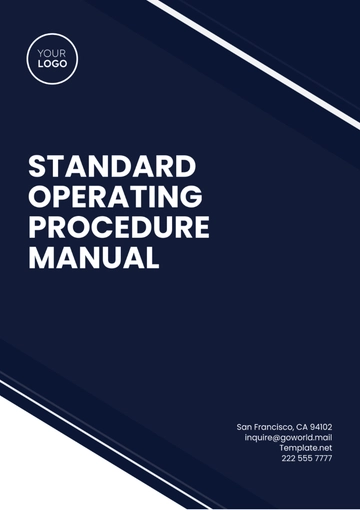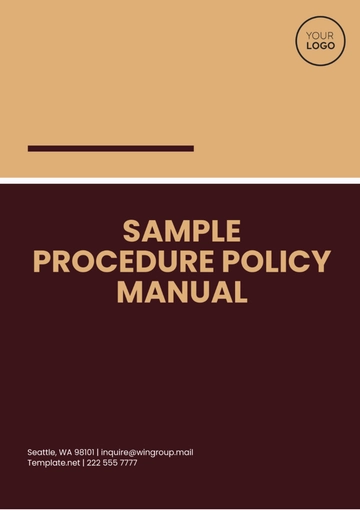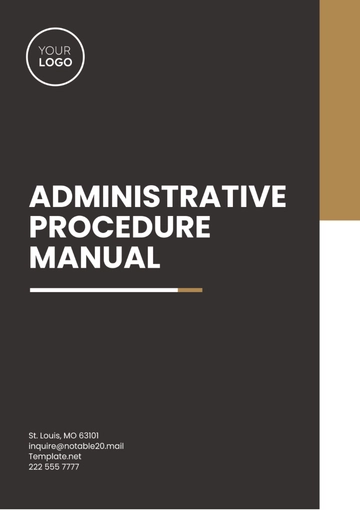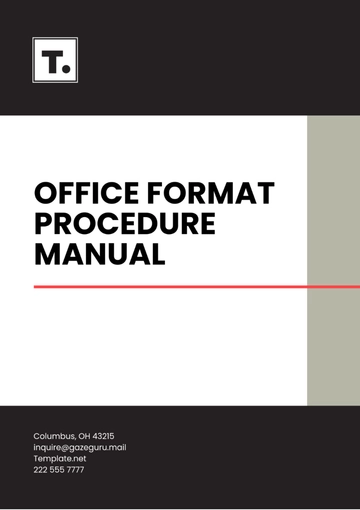Free Health & Safety Policy & Legal Procedure Manual

I. Introduction
This document is a comprehensive guide designed for [Your Company Name] to ensure not only compliance with national health and safety legislation but also to foster a workplace culture deeply committed to the well-being of every individual associated with our operations. This manual is a living document, subject to changes in laws, regulations, and our internal processes. All employees are expected to familiarize themselves with its contents and adhere strictly to the guidelines set forth herein.
II. Health & Safety Policy Statement
At [Your Company Name], we hold the safety and health of our employees and stakeholders as a core value, integral to our success and sustainability. Our commitment extends beyond mere compliance with statutory obligations; we are dedicated to maintaining the highest standards of occupational health and safety. This policy is a declaration of our intent to provide a safe and healthy work environment, to prevent accidents and cases of work-related ill health, and to continually improve our health and safety performance.
III. Organizational Responsibilities
A. Management Responsibilities
1. Developing and maintaining safety policies:
Management is responsible for establishing comprehensive health and safety policies that address the specific needs and risks of our work environment. This includes creating a framework for risk management, emergency response, and employee wellbeing.
2. Ensuring that all employees are aware of their health and safety obligations:
It is crucial that all employees understand their role in maintaining a safe work environment. Management must regularly communicate and reinforce the importance of health and safety regulations, ensuring that these guidelines are accessible and understood by everyone.
3. Allocating sufficient resources to meet these health and safety standards:
Management must ensure that adequate resources – including financial, human, and technical – are allocated to support health and safety initiatives. This includes investing in safety equipment, training programs, and health surveillance systems.
4. Regularly reviewing and updating workplace safety procedures:
The dynamic nature of the work environment necessitates continuous review and updating of safety procedures. Management should conduct regular audits, stay updated with the latest safety standards, and incorporate technological advancements into our safety practices.
b. Employee Responsibilities
b. Employee Responsibilities
B. Employee Responsibilities
1. Adhering to safety practices and using protective equipment as required:
Employees must strictly follow established safety practices and procedures. This includes the proper use of safety equipment and personal protective equipment (PPE) as mandated in their respective roles.
2. Reporting hazards, potential hazards, or malfunctions of safety equipment:
Employees are encouraged to actively participate in maintaining a safe work environment by promptly reporting any hazards, risks, or equipment malfunctions. This proactive approach is essential in preventing accidents and injuries.
3. Participating in safety training and drills:
Regular participation in safety training sessions and emergency drills is mandatory for all employees. This ensures that each team member is equipped with the knowledge and skills necessary to handle potential safety incidents.
IV. Risk Assessment Procedures
A. Identifying Hazards
1. Conduct comprehensive assessments to identify potential workplace hazards:
Regularly scheduled hazard assessments are conducted to identify potential risks in the workplace. These assessments involve a systematic examination of all work areas, processes, and equipment.
2. Encourage employees to report any observed risks or unsafe conditions:
A culture of open communication regarding safety is promoted, where employees are encouraged to report any observed risks or unsafe conditions immediately. This feedback is vital for continuous improvement in our safety protocols.
b. Evaluating Risks
1. Analyze the likelihood and potential impact of identified risks:
Once potential hazards are identified, a detailed analysis is performed to evaluate the likelihood and severity of these risks. This evaluation is critical in prioritizing risk management efforts.
2. Develop and implement strategies to mitigate or eliminate these risks:
Based on the risk assessment, targeted strategies are developed and implemented to mitigate or eliminate identified risks. This includes modifications to work practices, improvements in PPE, and enhancements in emergency response procedures.
V. Health & Safety Training
A. Training Programs
1. Comprehensive induction training for new hires:
New employees undergo extensive induction training, which covers all aspects of health and safety relevant to their roles. This training is designed to ensure that they start their roles with a strong foundation in safety awareness and practices.
2. Ongoing training programs tailored to various roles within the company:
Ongoing training programs are tailored to the specific needs and risks associated with different roles within the company. This ensures that all employees, regardless of their position, receive the training they need to perform their duties safely.
B. Record Keeping
1. Detailed records of all training, including participant lists and session content:
Accurate and detailed records of all training sessions are maintained. This includes information on the participants, the content covered, and the dates of training. These records are crucial for tracking compliance and identifying areas where additional training may be required.
VI. Accident Reporting and Investigation
A. Reporting Procedures
1. Clear guidelines for reporting accidents, including timelines and the documentation required:
A streamlined and clear process for reporting accidents is in place. This process outlines the steps employees must take immediately after an accident, including timelines for reporting and the types of documentation required.
2. A streamlined process for employees to report accidents, ensuring quick response:
The reporting process is designed to be straightforward and efficient, ensuring that accidents are reported promptly, and appropriate responses are initiated without delay.
B. Investigation
1. Thorough investigation protocols to determine causes of accidents and implement corrective actions:
Investigations into accidents are conducted thoroughly, aiming to identify the root causes. These findings are then used to develop corrective actions to prevent future occurrences.
2. Regular reviews of accident reports to identify patterns and areas for improvement:
Accident reports are regularly reviewed to identify any patterns or trends. This analysis is crucial for continuous improvement in our health and safety practices.
VII. Emergency Procedures
A. Evacuation Plans
1. Clearly defined evacuation protocols, including routes and roles:
Evacuation plans are clearly defined and communicated to all employees. These plans include specific evacuation routes and designated roles and responsibilities during an evacuation.
2. Regular drills to ensure familiarity with evacuation procedures:
Regular drills are conducted to ensure that all employees are familiar with the evacuation procedures. These drills are critical for preparing employees to respond effectively in an
B. First Aid
1. Accessible first aid kits and trained first aid personnel:
First aid kits are easily accessible throughout the workplace, and a sufficient number of employees are trained in first aid. These first aiders are strategically positioned across different work areas to ensure a swift response in the event of a medical emergency.
2. Procedures for handling medical emergencies:
Procedures for handling medical emergencies are clearly defined and communicated. This includes steps to be taken in the event of an injury or illness, as well as contact information for emergency services.
VIII. Health Surveillance
A. Health Checks
1. Regular health screenings for employees, with a focus on those in high-risk roles:
Regular health screenings are conducted, particularly for employees in high-risk roles. These screenings are designed to detect any health issues that may be exacerbated by their work environment.
2. Confidential handling and storage of health data:
All health data collected through these screenings is handled confidentially and stored securely. This data is used solely for the purpose of maintaining and improving employee health and safety.
IX. Equipment and Personal Protective Equipment (PPE)
A. Equipment Safety
1. Strict maintenance schedules for all equipment:
A strict maintenance schedule is adhered to for all equipment. This schedule includes regular inspections, servicing, and repairs to ensure that all equipment is safe and in good working condition.
2. Training for employees on the correct and safe operation of equipment:
Employees receive comprehensive training on the correct and safe operation of any equipment they are required to use. This training is regularly updated to reflect any changes in equipment or operating procedures.
B. PPE
1. Provision of high-quality personal protective equipment:
High-quality PPE is provided to employees, tailored to the specific risks associated with their roles. This equipment is maintained and replaced as necessary to ensure its effectiveness.
2. Training on the use, maintenance, and storage of PPE:
Employees receive training on the correct use, maintenance, and storage of their PPE. This training is essential for ensuring that PPE provides the intended level of protection.
X. Legal Compliance and Auditing
A. Compliance
1. Regular assessments to ensure alignment with current laws:
Regular assessments are conducted to ensure that our health and safety practices are in compliance with current laws and regulations. This includes staying informed of any changes in legislation that may impact our operations.
2. Responsive updating of policies as per changes in legislation:
Policies and procedures are updated responsively to reflect any changes in legislation. This ensures that our practices remain compliant and effective.
B. Auditing
1. Comprehensive internal and external audits of our health and safety practices:
Regular internal and external audits are conducted to assess the effectiveness of our health and safety practices. These audits are crucial for identifying areas for improvement and ensuring compliance with legal and regulatory requirements.
XI. Policy Review and Revision
A. Review Process
1. Annual review of this policy, or as required by changes in the operational environment or legislation:
This policy is reviewed annually or more frequently if required by changes in the operational environment or legislation. This ensures that the policy remains relevant and effective.
2. Inclusion of employee feedback in the review process:
Employee feedback is actively sought and included in the review process. This feedback is invaluable for ensuring that our health and safety practices are practical and effective.
B. Revision
1. Documentation of all revisions, with clear communication to all stakeholders:
All revisions to the policy are documented, and these changes are communicated clearly to all stakeholders. This ensures that everyone is aware of and understands the current health and safety requirements.
XII. Appendices
1. Appendix A: Forms and Templates
Detailed templates for reporting and risk assessment.
2. Appendix B: Legal References
Comprehensive list of relevant health and safety legislation.
Document Control
Issued By: [Name of Issuer]
Approved By: [Name of Approver]
- 100% Customizable, free editor
- Access 1 Million+ Templates, photo’s & graphics
- Download or share as a template
- Click and replace photos, graphics, text, backgrounds
- Resize, crop, AI write & more
- Access advanced editor
Introducing Template.net's Health & Safety Policy & Legal Procedure Manual Template. Fully editable and customizable, this comprehensive resource empowers you to establish robust policies and legal procedures. Utilize our Ai Editor Tool to tailor content to your organization's specific needs. Ensure compliance and safety with ease using Template.net's innovative solution.





























